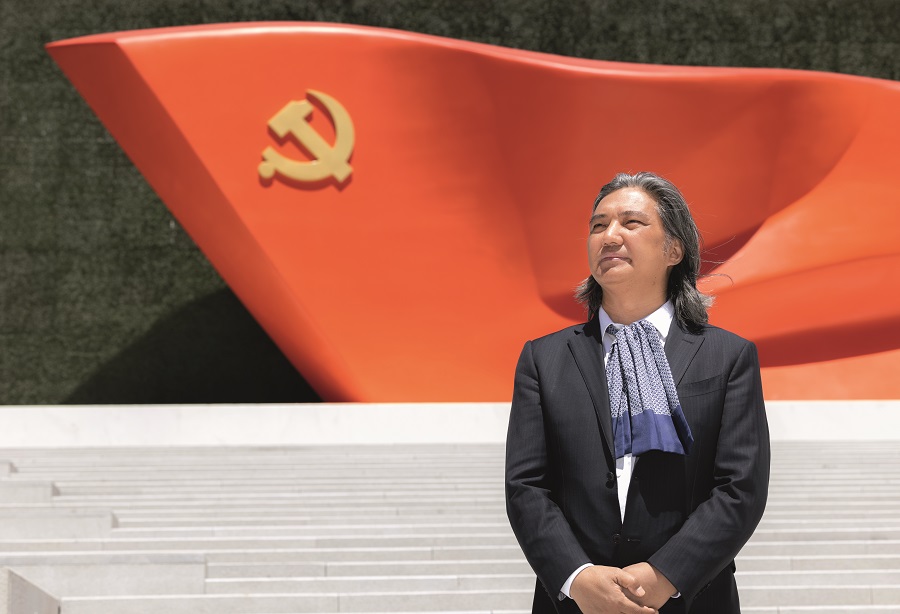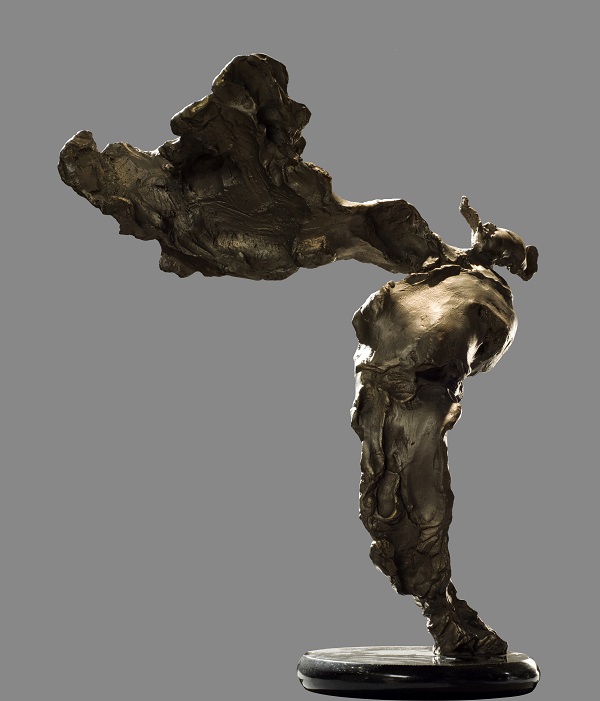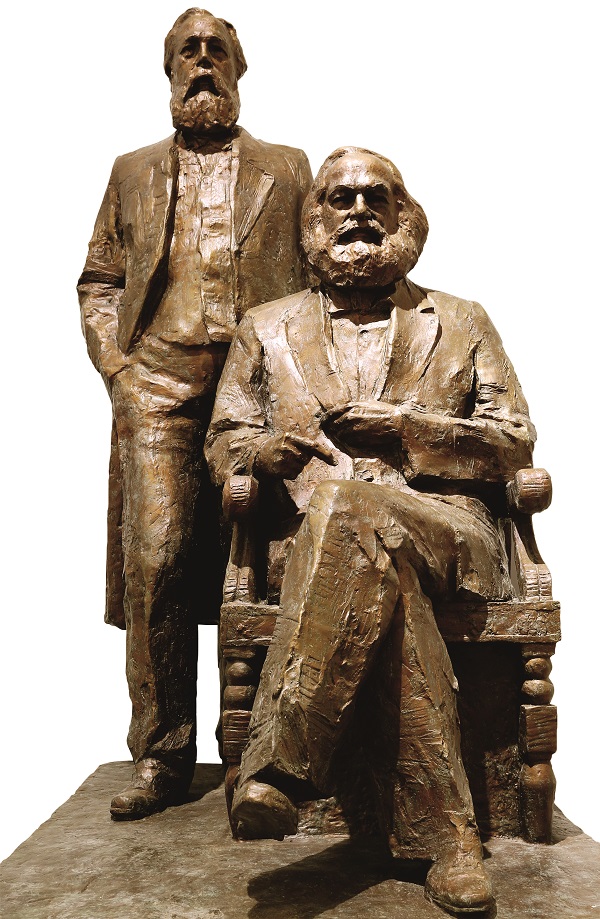Wu Weishan: Sculpting an Era

In the western half of the square in front of the new Museum of the Communist Party of China (CPC) is a huge CPC flag sculpture. The 7.1-meter-high and 21-meter-long flag was hand-forged with stainless steel. The smooth curves and delicate lines create the illusion that the flag is waving in the wind.
“The curved and straight lines in the work respectively represent the arduous and difficult journey of the CPC and the unswerving pursuit of noble ideals among CPC members over the past century,” said Wu Weishan, a world-renowned sculptor and curator of the National Art Museum of China.
“Visual representations of the times can be more vivid, straightforward, and artistic through sculpture,” he asserted. Since the late 1980s, Wu has been devoted to sculpting prominent Chinese figures from ancient and modern times.

Sculpting History
On July 1, 1945, just before the victory of the Chinese People’s War of Resistance against Japanese Aggression, seven political figures led by Huang Yanpei (1878-1965) were welcomed to Yan’an, then the headquarters of the CPC. They came for a private inspection upon an invitation from Mao Zedong.
On the afternoon of July 4, Mao received them in his cave dwelling. “A rise may be fast, but a downfall can be equally swift,” said Huang, reportedly. “Has any person, family, community, place, or even nation ever managed to break free of this cycle?”
“We have found a new path,” replied Mao. “We can break free of the cycle. The path is called democracy. As long as the people have oversight of the government then the latter will never slack. If everyone takes responsibility, there is no danger of things returning to how they were, even without a leader.”
In 2013, the Central Institute of Socialism commissioned Wu to produce a series of sculptures depicting the famous dialogue between Mao and Huang in Yan’an about the historical cycle. “Before starting, I spent three years on preparation which included visiting the cave dwellings in Yan’an and studying historical documents to properly grasp the historical background,” Wu said. “I had to understand the relationship between the two figures because I wanted to capture the moment of eternal history with static sculptures. I ultimately found that Huang was eager to ask such questions, and that Mao replied calmly and firmly. It was the first time that a top leader of the CPC Central Committee had conversed with democratic figures about the future of democracy in the country as well as one of the Party’s successful efforts in its united front work.”
In 2016, a sculpture of the two figures walking side by side was completed. In the sculpture, Huang shows an expectant and trusting expression, and Mao wears a cotton-padded jacket, his signature attire in Yan’an, unbuttoned, with one pocket seemingly carrying cigarettes, and maintains the demeanor of a romantic poet and distinguished leader. “They are walking the road to democracy, cooperation, and sincerity between the CPC and the country’s non-Communist political parties,” Wu explained.
Wu has completed statues of many outstanding figures of modern Chinese history including Mao Zedong, Deng Xiaoping, the chief architect of China’s reform and opening up, and Zhou Enlai, China’s first premier. “The extraordinary achievements and enterprising spirit of the Party over the past century offer artists considerable materials to explore,” asserted Wu. “The leaders who shaped our times are worth remembering by the people.”
While works depicting heroic figures emit a sculptor’s respect and passion, pieces like Mass Sculpture of the Nanjing Massacre convey powerful grief and indignation. The strikingly strong and sharp touches capture the artist’s sympathy, feelings about human dignity, and longing for peace. The sculpture Mission recognizes the dedication and responsibility of a female doctor fighting the COVID-19 epidemic and her fearlessness and determination to put herself in harm’s way. Wu chose alabaster for the piece to indicate the spirit of sanctity and benevolence of all medical personnel because a virtuous person is like precious jade according to traditional Chinese culture.
Freehand Sculpture
In Wu’s sculpture of Li Bai (701-762), a famous Chinese poet from the Tang Dynasty (618-907), the poet’s face can hardly be seen. Yet Chinese people were able to recognize the poet the moment the work was unveiled. “Outstanding figures like Li Bai mirror the spirit of their times whether they lived in the Tang, Song (960-1279), or other dynasties,” Wu said. “Chinese people are very familiar with this romantic, free-spirited poet. Capturing the spirit of the figure in my work is crucial.”

“His art concentrates more on the inner spirit and feelings of a subject rather than outer shape and form,” commented Fei Xiaotong (1910-2005), a pioneer of Chinese sociology and anthropology, on Wu’s work. Inspired by Western realism and Eastern freehand style, Wu’s art explores the natural integration of the inner spirit and outer shape of a subject.
“Traditional Chinese art was impacted by Western realism in the early 20th century and then Soviet socialist realism in the 1950s,” added Wu. “Since the beginning of China’s reform and opening up in the late 1970s, the greatest influences have been Western modernism and American contemporary art. In this context, I invented the concept of freehand sculpture.” Wu’s inspiration for the style came from the aesthetics of traditional Chinese calligraphy and painting.
Whether creating a sculpture of a contemporary leader or an ancient sage, Wu always pinpoints the most distinctive features of the subject to deliver vivid work. His “freehand sculpture” style is rooted in the artistic philosophy of traditional Chinese calligraphy and painting and driven by the humanistic sensitivity of the Chinese nation, yet it resonates with the rest of the world and bridges the East and the West.
One of his best-known works, A Dialogue Across the Time, consists of two bronze sculptures depicting Italian Renaissance figure Leonardo da Vinci (1452-1519) and modern Chinese artist Qi Baishi (1864-1957) engaged in a sort of hypothetical conversation transcending time and geographical distance, symbolizing cultural and artistic exchange between China and Italy across time and space. A smaller version of the work was installed at the Academy of the Arts of Drawing in Florence, Italy, in 2019. It was the first time an Italian art academy commissioned and displayed work by a Chinese sculptor. Wu was also the first Chinese sculptor to receive the title of honorary academician and win the Michelangelo Prize presented by the academy.

Many of Wu’s works are permanently held by institutions around the world. His sculpture Marx is located in Trier, Germany, the hometown of Karl Marx (1818-1883). His sculpture Confucius stands in Curitiba Civic Center Plaza in Brazil, and another depiction of Confucius is held by the Fitzwilliam Museum in the U.K. His Centennial Monument—Large Monument to the Work-study Program in France was placed in Deng Xiaoping Square in Montargis, France, where Deng worked and studied in the early 20th century. “My mission as an artist is to create an inclusive and diverse global cultural atmosphere while exploring and inheriting the Chinese nation’s own distinctive culture,” Wu added.

Didier Bernheim, a Correspondence Fellow with the French Academy of Art, once said Wu’s art is powerful, touching, and universally aesthetically valuable. In 2018, Wu became the second Chinese artist to be elected as a Correspondence Fellow of the academy.